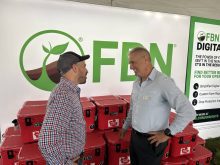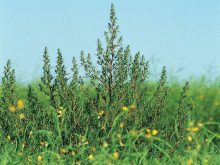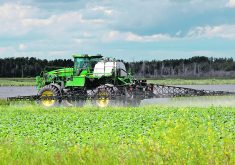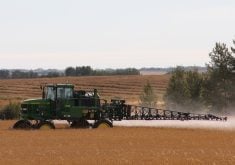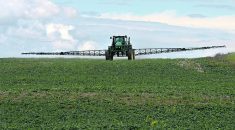Ray Harrington considered catching, carting, cremating and cooking weed seeds to control the herbicide resistant varieties that were plaguing farmers across Western Australia.
He settled on a fifth C: crushing.
Now the developer of the Harrington Seed Destructor is testing a combine-mounted model that will replace the prototype pull-behind unit that first gained attention in Australia and elsewhere.
“We’ve come along in leaps and bounds the last two years,” said Harrington at an Aug. 12 presentation in Lethbridge.
“The trail behind is working, but people don’t want it. I don’t want it. I’m just trying to get rid of two. I’ve got two and they’re both on the market.”
Read Also

Why feds imposed EV tariffs
Moe and Kinew have a fight on their hands when it comes to eliminating the EV tariff. Canada has to worry about pissing off the U.S. and Mexico and hundreds of thousands of auto workers.
Tests show the pull-behind units destroy 92 to 98 percent of weeds seeds at harvest.
The design is based on cage mills used in coal mines to pulverize material.
Agriculture Canada has bought a pull-behind unit that will be used first in Ontario, possibly this year, and later in Western Canada.
“We’re in the process of purchasing one right now as a research tool, so we hope to be working with that on farm fields in the next several years in terms of seeing whether it will work in our situation and work with some of our weed species,” said Agriculture Canada weed science researcher Bob Blackshaw.
Harrington and Michael Walsh of the Australian Herbicide Resistance Initiative said the seed destructor is a useful tool for weed control at harvest.
However, interest and adoption are expected to be much higher if the unit is mounted within the combine.
If all goes well with Harrington’s most recent prototype, it could be available in Canada within five years.
“We’ve got to be careful not to rush out there and it’s not right,” he said.
He and others involved in the Destructor’s development have been working with Case IH, but Harrington said the combine-mounted units will have to fit all models.
“We’ve got to all get in the show together,” he said.
“It’s about the weeds anyway. It’s not about financial gain. It’s all about killing weeds. It’s all about staying farming.”
The most recent challenge was ensuring the Destructor didn’t sap too much horsepower from the combine and slow harvest speed.
Harrington said the latest model requires about 70 h.p., down from 100 in the initial combine mounted design.
“We’ll still improve it a bit more yet, and it’s all about where and horsepower. We just keep reducing that horsepower. We can then put it in a bit smaller combine.”
Harrington farms 5,000 acres in Darkan, Western Australia, which is south of Perth. He has been practicing no-till agriculture since 1995, the same year he sold his sheep and went into continuous cropping.
He knew then that his region had major problems with herbicide resistant weeds but rejected the solutions tested by other farmers.
This year, he tested the first combine-mounted seed Destructor on his own farm at harvest.




